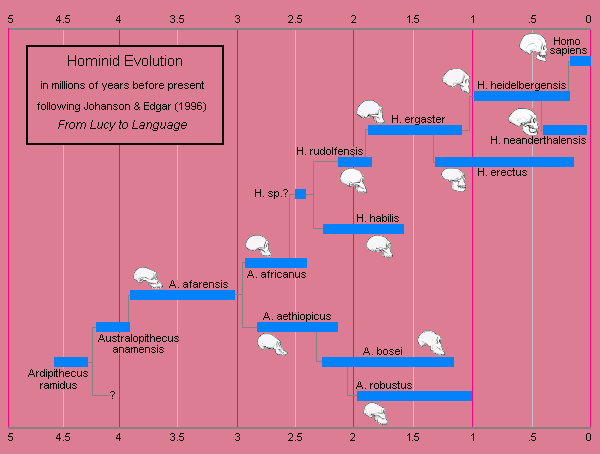 〔Bob Patterson氏によるDarwiniana andEvolutionの中の『Human Origins』から〕 ヒト(ホモ)属は約250万年前(?)に誕生した。 |
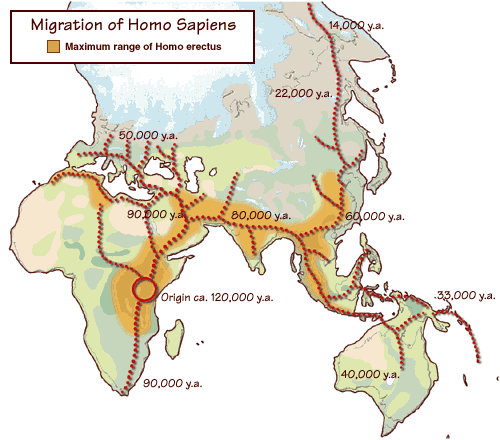 Around 120,000 years ago Homo sapiens emerged as a new species, most likely in central East Africa, and from there migrated into the Middle East, south Africa, Europe, central Asia, and finally into the New World. To reach the Bering Strait from Africa by 14,000 years ago, humans would have had to wander no more than one mile every eight years. -- The timing of Ice Age coolings, and the amount they lowered ocean levels, specifies the geologic periods in which it was possible to migrate to land masses otherwise separated by water. 〔Bruce MacEvoy氏によるhandprint の『Human Evolution』の中の『Hominid Fossil Sites and Patterns of Hominid Dispersal』から〕 ホモ属サピエンス種は約12万年前にアフリカで誕生した。 |
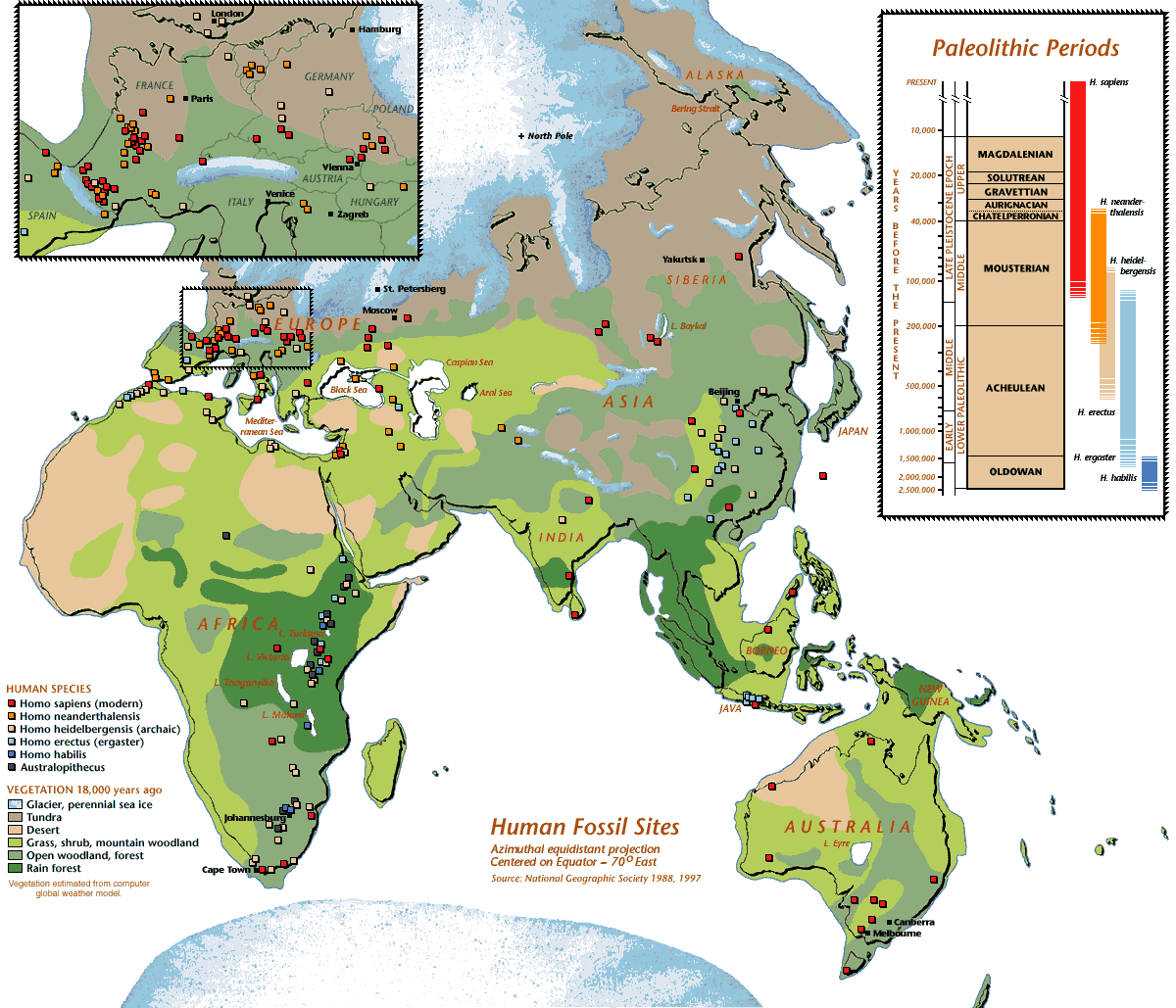 〔Bruce MacEvoy氏によるhandprint の『Human Evolution』の中の『Hominid Fossil Sites and Patterns of Hominid Dispersal』から〕 人類の化石の分布と1万8000年前の古植生。 |
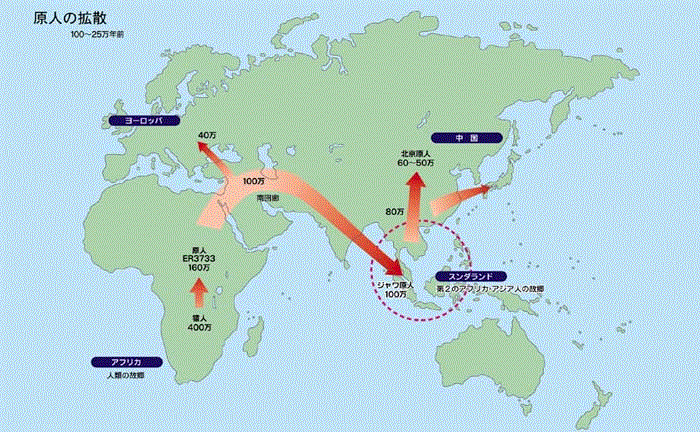 100万年前にアフリカを出た原人はユーラシア大陸の回廊を通ってスンダランドに到達した。そこで繁栄したのがジャワ原人である。彼らはやがて、北へ向かって北京原人になった。その一部は日本列島にも流入した。(馬場 1993年) 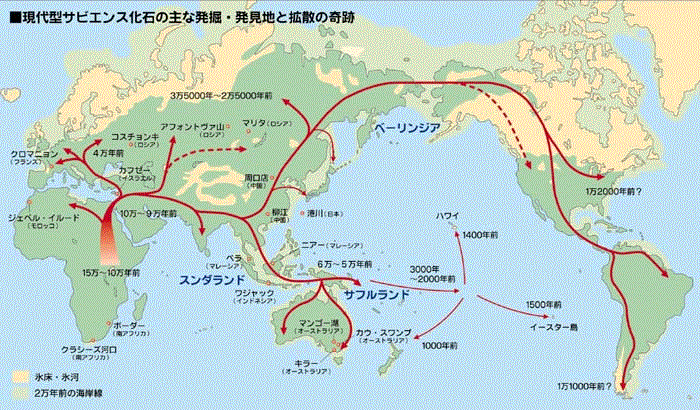 「新人アフリカ単一起源説」に基づいて描いた新人(現代型サピエンス)の拡散。10~15万年前に、アフリカでいち早く現世人類へと進化した人々が、その後アフリカから世界中に広がって各地の原人の子孫達と置換した、とする説で、遺伝子分析の結果(イブ仮説)からも支持されている。しかしその一方で、特にアジアでは北京原人などにすでに現代モンゴロイドに繋がる特徴が現われており、化石の形態にも連続的な変化が見られることから、この説に対する批判も根強い。ウォルポフらは、100万年余り前にアフリカから出た原人達が、世界各地で次第に地域色を強めて新人へと進化した、とする「多地域進化説」を提唱して反論している。はたしてどちらが真実なのか、目下、世界中の人類学者を巻き込んだ激しい論争が続いている。 〔九州大学総合研究博物館の『インターネットミュージアム』の中の『倭人の形成』の『モンゴロイドの拡散』から〕 |
 〔UNEPの『Maps & Graphics』の『Vital Climate Graphics』の『Potential impacts of climate change』から〕 ブロッカーがモデル化した『海洋ベルトコンベアー』。北大西洋で沈み込んだ深層水は、南下後、インド洋および太平洋で上昇して表層水となり、北大西洋へ戻ってくる。この一循環には約2000年かかる。 |
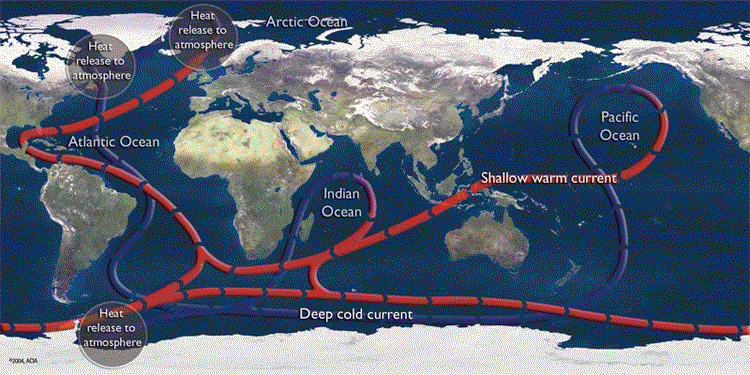 Figure 8q-2: The following illustration describes the flow pattern of the major subsurface ocean currents. Near surface warm currents are drawn in red. Blue depicts the deep cold currents. Note how this system is continuously moving water from the surface to deep within the oceans and back to the top of the ocean. (Source: Arctic Climate Impact Assessment -ACIA). 〔Okanagan University CollegeのDepartment of GeographyのMichael Pidwirny氏によるPhysicalGeography.netの『FUNDAMENTALS OF PHYSICAL GEOGRAPHY』の『CHAPTER 8: Introduction to the Hydrosphere』の中の『(q). Surface and Subsurface Ocean Currents』から〕 ブロッカーのモデルを少し修正したもの。北大西洋での沈み込み場所が2ヶ所となっている。 |
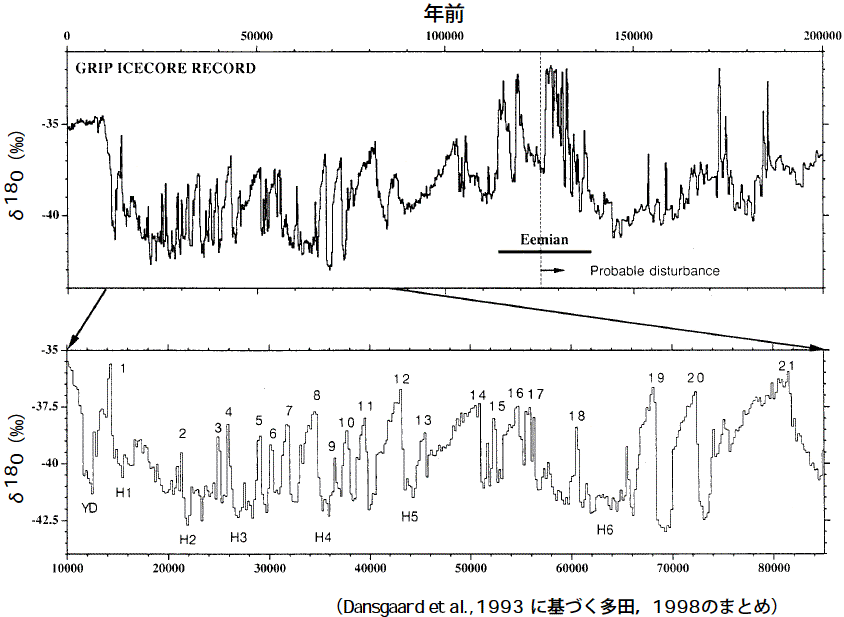 図2.6-10 グリーンランドの氷床コアに見られるダンスガード-エシガーサイクル 〔 核燃料サイクル開発機構による『研究開発の現状』の『地層処分技術に関する研究開発』の中の「わが国における高レベル放射性廃棄物地層処分の技術的信頼性-地層処分研究開発第2次取りまとめ-」 (平成11年11月26日原子力委員会提出) の『分冊1:わが国の地質環境』の中の『2.6 気候・海水準変動』から。〕 YDとH1~H6はハインリッヒ事象。 |
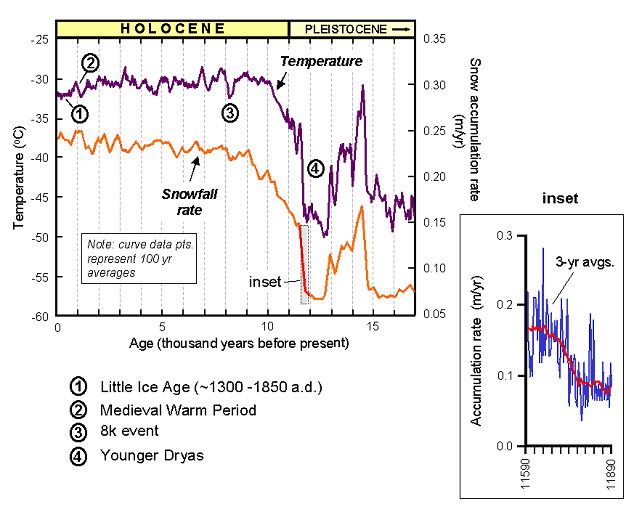 Temperature changes in central Greenland over the Holocene. (modified from Committee on Abrupt Climate Change report, National Academy Press, 2002) 〔Lowell E. Waitee氏によるWelcome to Geocomplexity.comの中の『Climate Change: Lessons from Geology and Complexity Science』から〕 中央グリーンランドの氷床コアから得られたデータによる、過去1万7000年間の気温と降雪速度の変動。 |
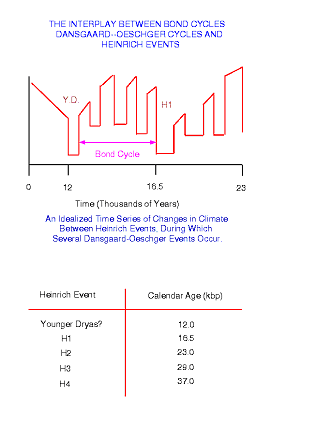 |
The coincidence between Heinrich events (eg. H1 or perhaps
the Younger Dryas YD) and major changes in temperature in the
North Atlantic leads to the speculation that fresh water released
as a result of melting of icebergs disrupted North Atlantic Deepwater
(NADW) formation, or at least diminished its strength and depth
of formation, giving rise to jumps between glacial and interglacial
modes of the thermohaline circulation. See the papers: Iceberg discharges into the North Atlantic on millenial time scales during the last glaciation. Bond and Lotti, Science, Vol. 267, 1005-1010, 1995 |
|
〔A.F. Fanning氏による『Information on Glaciation』の中『BOND CYCLES, HEINRICH EVENTS, AND DANSGAARD-OESCHGER EVENTS』から〕 約1500年周期のダンスガード=オシュガー振動が数回繰り返した後に、巨大な氷山が放出されたハインリッヒ事変が生じている。これらは、氷床の融解が海洋ベルトコンベアを停止させて寒冷化をもたらすというようなシナリオで、ボンドにより説明が試みられており、ボンド周期と呼ばれる。 |
|